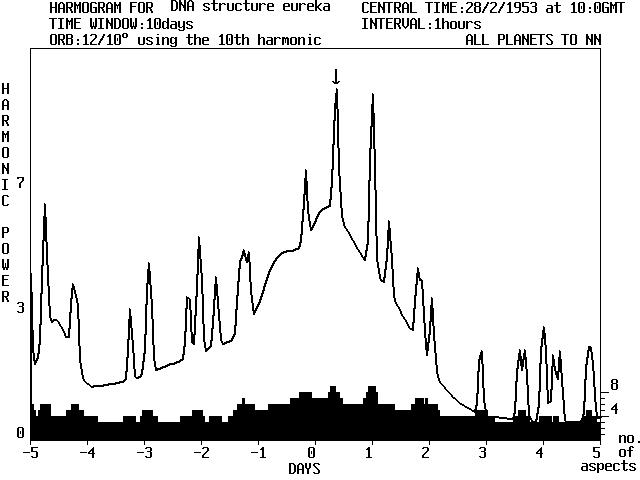
The Harmogram program was written by Mike O'Neill and used in the book: "The Eureka Effect" (written by Kollerstrom and O'Neill, published by the Urania Thrust in 1996).
Download the program, then double-click on "harmo.exe" to unzip the
files, then double-click on "harmogrm.bat" in the directory c:\harmo to
start the program.

Introduction
The Harmogram is a new tool for astrologers. It measures the strength
of a celestial aspect and depicts the flow of a harmonic through time.
For example, the 'third harmonic' measures the strength of trine aspects,
the fifth harmonic measures quintile aspects and so forth. Thus, the strength
of opposition aspects would be measured by the 'second harmonic'.
For thousands of years astrologers have been limited to a single moment
of time - when the chart is cast. Now, at last, the Harmogram can show
the strength of a celestial aspect varying over any chosen period. It takes
astrology into the third millenium. Use it, and be one of the avant-garde.
For example, if you wish to schedule a conference that will be an inspirational
experience, check out the seventh harmonic for the year ahead, perhaps
omitting the lunar aspects. Find a day of strong septiles. The 'inspirational'
septile aspects are represented by the seventh harmonic.
The Harmogram lets you set the 'base orb' of an aspect, and one can
use twelve degrees for that. This will give a 6° orb for the opposition
(2nd harmonic), a 4° orb for trines, and in general 12/n° orb for
the nth harmonic. If you want more than 4° for the trine (3rd harmonic),
then set a larger base orb, eg 18° will give 6° orb (This orb-definition
is based on a suggestion by harmonics-pioneer John Addey).
The Harmogram measures 'aspect power', which increases in proportion
to closeness of orb, and becomes maximal at exactitude. The program uses
a 'Gaussian' or 'normal' curve to model this (or, you have an option of
a simpler, 'triangle' version, where strength increases linearly with orb).
At the bottom of the harmogram you see a 'city skyline' effect, which
depicts the varying number of aspects, for the orb chosen. The graph shows
a continuous function, the flowing 'aspect power'.
The program gives you the option of adding two different harmonics
together; but, just put '0' for the second choice if you only owant one.
For the choice of 'Interval' (in hours), you tell the computer how often
to compute the values - the smaller the interval, the longer it will take.
Type in '10' for the 'all planets' choice. Over a long period of time (eg
a year), you might wish to omit the lunar aspects, which come and go quickly.
There is a companion booklet, The Harmogram Concept for more details.
Default Settings
The options you will usually require come as standard defaults.
These include: selecting all of the planets, including the Moon, having
a Gaussian-type curve to represent the shape of aspects, excluding the
conjunctions, and having a twelve-degree base orb. Put '1' (for 'yes')
at the 'default' stage to select these.
Worked Example: First Jet Plane Flight on 15.5.41, with third
Harmonic
Choose '1' for defaults. Or, to check them out, put '0', then:
Choose '10' to include all planets but not the North Node
Choose '1' to include the Moon
Choose 1 for Gaussian curve
Choose '0' for non-inclusion of conjunctions
For Title write 'Jet plane'
Insert 15,5,41 for date: 15th May 1941.
Insert the launch time required, 17.50 (GMT)
For Days insert 30, which plots ±30 days from time-zero.
For Interval put 6 hours, so computations are done every 6 hours.
For Base orb put 18, giving trines a maximum orb of 6° (18/3).
For Harmonic put 3, then zero for second option
When finished, press any key and to exit type '0'
Notes
* The vertical scale is adjusted to give the same
average value, as that of the aspect-score along the bottom. The latter
is calibrated in the bottom right-hand corner.
* To see how the harmogram is using a normal curve
to represent aspects, just put '2' for all planets. This will select only
the Sun and Moon. Then, for any harmonic you select, and any orb, you will
see the separate bell-shaped curves (or triangles, if you select these).
Use an ephemeris to find an event, then check it out using the Harmogram.
* The sequence of planets is: Sun, Moon, Mercury,
Venus, etc out to Pluto. So, to exclude the outer three planets put '7'
for the 'all planets' choice.
* If you want to put 'yes' for the 'include conjunction'
option, this will give more or less the same mean value for any harmonic,
at a given base-orb; eg, the 3rd harmonic would then include three positions,
of the two trines plus the conjuction.